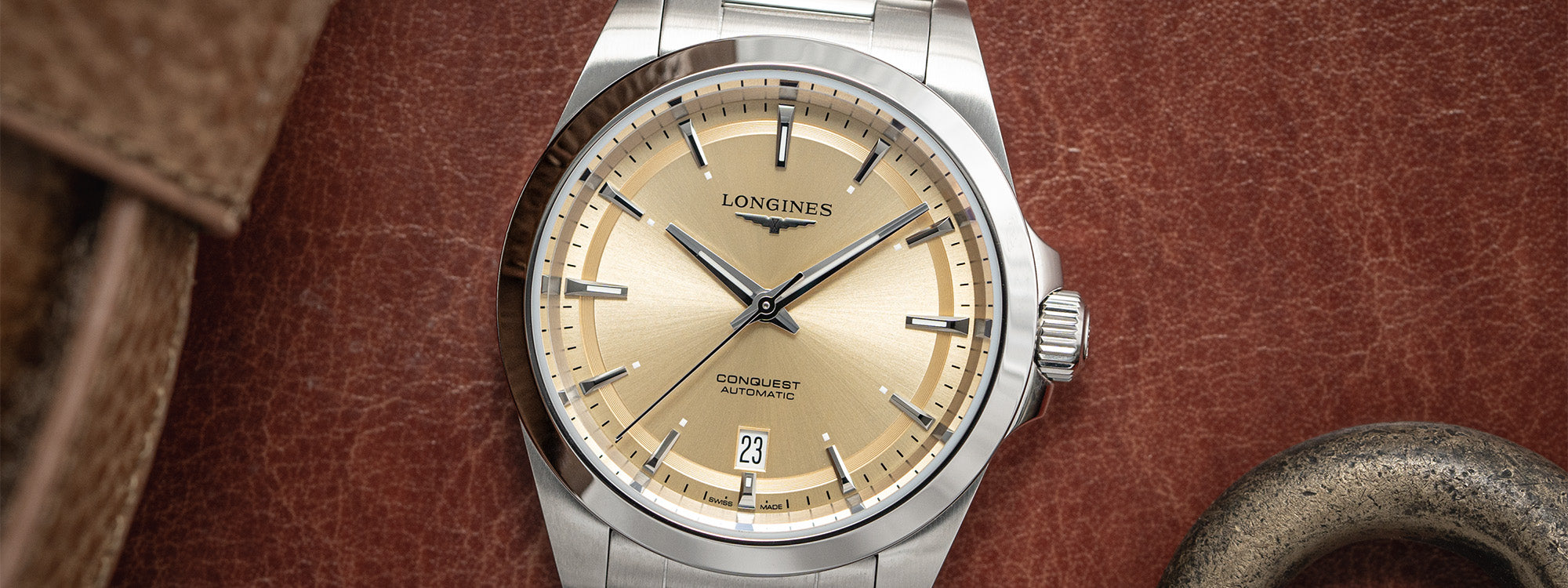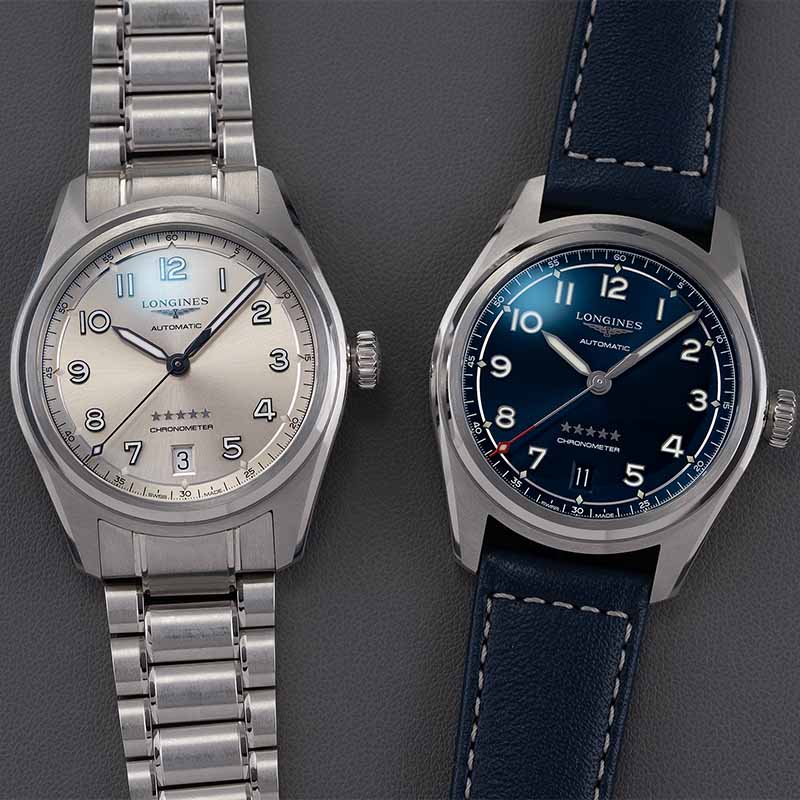Last year, Longines relaunched the Conquest, a mainstay of its collection since the mid-1950s, in a new execution heavily influenced by its earliest vintage forebears and staking out a dressier territory than its sporty dive-watch sibling, the Hydroconquest. Longines set out to expand the new Conquest’s appeal this year with a new series of models in unisex 38mm cases. Read on for a hands-on review of the new Conquest 38 with an effervescent champagne dial.
Longines, founded in 1832 in the Jura valley of Switzerland, where it remains headquartered today, can claim a variety of milestones in its long history, including one that is largely overlooked. In the 1950s, Longines became one of the first watchmakers to introduce product “families,” today a staple of the watch industry; the first was the Conquest collection, whose name was registered on April 3, 1954 with the Swiss Registry of Intellectual Property and which launched that same year. Like just about any timepiece well past the half-century mark on the market, the Conquest has evolved substantially over the decades since.

The first Conquest (Heritage re-edition pictured above) was a model of midcentury masculine simplicity, and one of the first wristwatches notable for its high levels of waterproofness and magnetic resistance. Its steel case measured a modest (but at the time standard) 35.2mm and fastened via wide, chamfered lugs to a leather strap. Its champagne-colored dial had arrowhead-style notched indexes at 3, 6, 9, and 12 o’clock and wedge-shaped notched markers at the other hour positions, swept over by sharp Dauphine hands. Its movement, an automatic Longines 19AS, ticked away behind a solid caseback with a decorative medallion depicting a fish to represent the case’s water resistance. From there, it was off to the races, with Longines continuing to expand the Conquest line with new models and complications and to evolve its design throughout the subsequent decades.

In 2007 came the most familiar version of the Conquest (at the time branded as the Conquest Sport, example above), which retained some of the minimalist elements of the original but added some decidedly bolder touches too, like the large Arabic numerals at 12 and 6 o’clock, rectangular indexes at the other hour markers, sword hands, and 3 o’clock date window. It is this version of the Conquest that inspired its even sportier offshoot, the dive-ready Hydroconquest, which has blossomed into a popular product family of its own — so popular, perhaps, that the core Conquest model may have gotten a bit lost in the shuffle, sporting much of the same design elements and the same robust 300-meter water resistance, but minus the tool-watch cool factor.

Whatever the motivation, Longines set out to remedy the Conquest’s perceived staleness with a revamp in 2023 that caught many enthusiasts’ attention. In keeping with Longines’s modus operandi in the 21st Century, the brand’s designers reached back into its archives for inspiration, bringing the Conquest a bit closer to its 1950s roots as a stylish but sturdy gents’ watch. The 41mm steel case of the first models sported a wider sloping bezel, elegantly curved crown guards, and a sunburst dial with thinner, tapered applied indexes and no numerals to be found, other than those in the subtle 6 o’clock date window. The watch, which came in 41mm and 34mm cases — at the higher end, actually a bit larger than the 39mm of their pre-redesign predecessors — garnered acclaim for its back-to-basics aesthetic but the lack of a “midrange” option between the two sizes proved to be a sticking point for some of its potential customers. As it has done fairly consistently in recent years, Longines listened to its fans and delivered: the 38mm version of the Conquest dropped in Spring of 2024. I was able to spend some hands-on time with one of the leader models in the new family, the Ref. L3.720.4.62.6 with a champagne-colored sunburst dial that most closely evokes the vintage look of the 1954 original.
The Case:

To be honest, I expected to be a bit underwhelmed by the case dimensions of the new Conquest 38; though my wrists are fairly slender, I tend to find the sweet spot around or just past the 40mm frontier and I am not always enamored of the “shrinkage” trend that is all the rage in watches today; to this longtime industry watcher, it feels like the style pendulum is swinging just a bit far to the opposite extreme of the “oversized” trend of the 2000s and 2010s. But when I put the watch on, I was surprised just how perfect the dimensions of the case looked and felt. The case middle isn’t really round but sort of barrel-shaped; on the right side, a pair of blunt, claw-like guards curve slightly outward to grip the threaded crown, which screws down tightly into the case. The crown has fluted sides for fingers to grasp easily and a small relief logo engraving on its surface. Rising above the satin-brushed surface of the case lugs is a polished, convex-curved round bezel, framing a sapphire crystal that subtly continues its curvature before culminating in a flat front. A similarly curved bezel, with its own sapphire pane, serves as the caseback; this one has six deep indents — for use in its removal by a watchmaking tool for servicing — and a brushed rather than polished finish. At 11.1mm in thickness, the watch slides easily under a shirt cuff; at 47.6mm lug to lug, it should occupy a fair amount of real estate on most wrists without ever being overwhelming or overwhelmed.
The Dial:

Longines offers five dial colors in the new Conquest 38 line: silver, black, bright blue, metallic green, and the champagne hue of my review watch. (These are mostly the same options offered by the 41mm models, except that the champagne dial replaces the brown dial of the larger watches.) All of these colorways are enhanced with a sunray treatment that catches light to create interesting highlights and shadows on the dial. A closer look reveals a large, slightly upraised central dial area with the brushed gradient pattern radiating from the center — interrupted near the outer edge by a thin, snailed circle that underpins the applied hour indexes, before continuing to the edge with its black-printed minute markers. The indexes themselves are carefully shaped and subtly faceted, with polished surfaces.

A smattering of green-glowing Super-LumiNova is applied to the markers at 12, 3, 6, and 9 o’clock; the 6 o’clock marker, of course, is truncated in size due to the presence of the small, faceted date window directly above it. A strip of Super-LumiNova is also applied to the center of the hour and minute hands, which have a tapered baton shape and a polished finish. Also of note: the tiny white squares that align with all non-cardinal hour markers, which are all but imperceptible in daylight but glow emerald in the dark to reveal their spot applications of luminous material.

Of course, even though the placement of the date indicator at 6 o’clock nicely balances out the Longines winged hourglass logo at 12 o'clock, and is thus far less disruptive to the dial’s symmetry than a 3 o’clock window would have been, some “purists” will decry the presence of the date window in any form. I am not one of those people, but one can’t help wondering if a no-date design was considered at any point for these smaller models, especially as the overall aesthetic of the new Conquest evolution seems in many respects to be all about simplicity and streamlining.
The Movement:

One aspect of the original 1950s Conquest models that hasn’t carried over into the 21st-Century versions is the solid medallion caseback, which these days has become an identifier for another vintage-inspired Longines collection, the Flagship. Sapphire exhibition backs are the standard for Conquest watches today, including the new 38mm models. The movement on display behind them is the proprietary Caliber L888.5, a self-winding mechanical movement with a handful of small but significant upgrades from its predecessor, Caliber L888. The lineage of the movement can be traced to the ETA A31.L11A, which is itself based on the ETA 2892-A2; ETA, for those not in the know, is the Swiss movement-making giant with which Longines shares corporate parentage under the Swatch Group. The noteworthy technical details that elevate the “point five” version of the movement are its silicon balance spring, which aids greatly in its magnetic resistance, its 25,200-vph (3.5-Hz) balance frequency, and its 72-hour power reserve, stored in a single, large barrel.

Peering through the sapphire pane in the back reveals the decorative finishes applied to the movement, like the vertical côtes de Genève on the ax-head-shaped rotor, which also bears a carefully cut-out silhouette of the Longines winged hourglass emblem and a gold-inscribed “Longines” in cursive below it. The rotor swings in both directions over a perlage-decorated plate, itself carefully cut to reveal the oscillations of the balance wheel, fed by the silicon balance spring.
The Bracelet:

The stainless steel bracelet of the Conquest 38 is an attractive amalgam of H-shaped outer links, with a satin-brushed finish, cradling a row of ingot-shaped center links with a contrasting polished surface. The bracelet has a slight taper — from 19mm down to 16mm — as it flows from the lugs to the clasp, and its overall feel is pleasantly supple. The double-folding clasp disengages easily with two thin push-buttons, and snaps securely shut with an end-piece engraved with a Longines logo. The combination of sleek, brushed and polished metal elements and the gold tones of the champagne dial make an impression that is at once “everyday” understated while also being elegantly refined. Those who generally prefer bolder, more contrasting colorways and a sportier aesthetic would probably opt for the black, blue, or green dial versions of this watch, while others seeking a dressier style might prefer the silver-toned dial that imparts an even more sober, monochromatic look. In terms of representing a happy medium, however, in both size and colorway, it’s hard to beat this champagne-dialed model, especially at an MSRP just over $2,000.





















































0 Comments